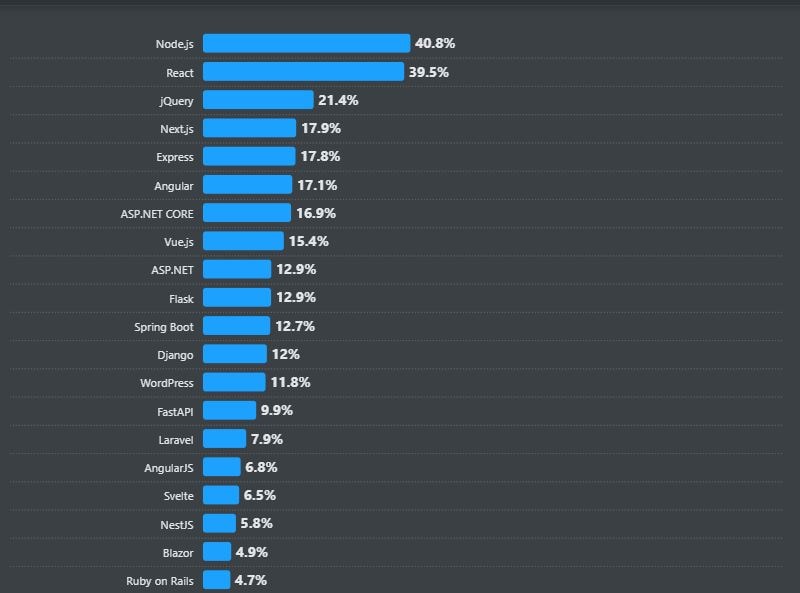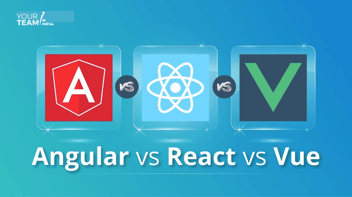Quick Summary: React and Vue are popular front-end technologies that developers often choose. Selecting one among React and Vue significantly impacts web project success. This blog compares two leading JavaScript frameworks based on key factors such as learning curve, flexibility, and scalability, to help you select the right technology for your development needs.
React has 41.8 million weekly downloads, while Vue has 6.7 million. The numbers tell only half the story. The real question is not which framework is more popular. But which one aligns with your project's specific needs.
And when it comes to narrowing down the choice between React and Vue. It is not just a technical consideration. It can directly impact the development speed, maintenance costs, and your ability to hire dedicated developers.
According to the latest Stack Overflow survey, React holds a 39.5% market share, while Vue has 15.4% as shown in the image.

Both frameworks are among the top front-end technologies and have unique strengths that can greatly influence your project's success. This blog will explore the main differences between these technologies to help you understand the aspects to be taken care of. Let us begin.
Key Takeaways
- React tends to have a steeper learning curve due to its reliance on JSX and the need to integrate additional libraries for state management. Vue, in contrast, is celebrated for its gentle learning curve and straightforward setup.
- React is ideal for large, complex enterprise applications. In contrast Vue is better suited for small to medium projects and can scale when necessary.
- React and Vue offer similar runtime performance due to their efficient Virtual DOM implementations.
- Both are suitable for different types of web apps, like single-page applications (SPAs) and progressive web apps (PWAs).
A Quick Overview of Vue vs React
React and Vue are among the most popular JavaScript technologies, known for their large communities and extensive ecosystems.
React.js is a JavaScript library made by Meta for building user interfaces. It was first developed in 2011 for Meta’s own use. Now, it is one of the most popular tools for creating interactive user interfaces.
React.js helps developers quickly and easily create single-page applications (SPAs). While most people use it for web development, it’s also useful for mobile app development for both iOS and Android using the React Native framework. This allows developers to create mobile-friendly components efficiently.
Vue.js is an open-source JavaScript framework for building web user interfaces and applications. Evan You, a former Google employee, created it in 2014 to offer a more flexible option than Angular. It is a popular tool for web development. It is simple to learn and adaptable. Vue.js helps create web apps using a component-based model and html templates, which is efficient and user-friendly.
Comparing Vue JS vs React JS: Key Differences
Reactjs and Vue.js are both leading JavaScript technologies for building user interfaces. However, they differ in their approach and features. Take a quick glance at their differences to gain a better understanding.
|
Parameter |
React.js |
Vue.js |
|---|---|---|
|
Type |
JavaScript core library for building UI components |
JS framework with a core library for building interactive UIs |
|
Developed By |
|
Evan You |
|
Learning Curve |
Moderate – requires learning JSX and ecosystem tools |
Easy – simpler syntax and setup |
|
Flexibility |
Highly flexible, but requires third-party libraries for routing, state, etc. |
More opinionated with built-in solutions like Vue Router and Vuex |
|
Performance |
Fast and efficient |
Equally fast for most use-cases |
|
Community Support |
Large and mature community |
Growing community with strong adoption |
|
Use Case |
Suitable for large-scale apps and complex projects |
Great for small to medium apps and quick project setups |
|
Data Binding |
One-way data binding |
Two-way data binding (but supports one-way too) |
|
Documentation |
Good, but requires piecing things together |
Very detailed and beginner-friendly |
|
Rendering |
Server-side rendering |
Server Side Rendering |
|
Scalability |
More scalable |
Less scalable |
Both React.js and Vue provide a core library that delivers essential functionality, and developers can extend this core with additional tools and libraries as needed. Now that we had a quick overview on the key differences, let us begin with understanding these differences in detail.
Architectural Approach
Both Vue.js and React.js use a component-based architecture. With this architectural approach, the user interface is divided into independent and reusable units. It helps developers to create modular and manageable applications. Dedicated frontend development teams benefit from this component-based architecture by efficiently managing project complexity and ensuring scalability for large applications.
This modularity also simplifies the process when you look to hire React developers or Vue developers, as their expertise can be quickly applied to specific parts of your project. Check out the architectures of React and Vue.js.
Architecture of reactjs
React is a JavaScript library that focuses on the view layer of an application. It is built around two main ideas:
-
Developing using component structure
-
Having unidirectional data flow
Now, take a look at the components of the reactjs architecture:
Component-Based
User interfaces are divided into separate & reusable react components, which serve as modular building blocks. Each react component controls its own state and displays its part of the user interface.
Unidirectional Data Flow
Reactjs allows data flow in one direction. This flows generally from parent components to child components through props. The single-direction flow makes data flow predictable and debugging easier.
JSX
React code development uses JSX. It is a syntax extension that allows writing HTML code within JavaScript. Developers use JavaScript code within JSX to define component logic and efficiently update the UI. JSX’s use allows the development of self-contained UI components with embedded logic.
Flexibility in State Management
React itself does not provide a built-in state management. So, it requires developers to integrate external libraries like Redux for state management across components, which is supported by the react community.
React's architecture is designed to minimize unnecessary re-renders, which improves performance and responsiveness.
Since React focuses primarily on the UI layer, developers often need to write code to integrate additional features and technologies.
Also read: Top React Libraries to Try in 2025
Architecture of vue.js
Vue is a framework for building intuitive interfaces. It follows the Model-View-ViewModel (MVVM) pattern that helps organize code logically.
Component-Based
The component-based architecture of Vue is similar to React. Vuejs uses the component architecture for modularity and reusability. This approach is a key reason why many choose to hire Vue.js developers, as it leads to more manageable and scalable applications.
Template-Based
Vue uses a standard HTML-based template syntax. It divides the structure into clear sections for HTML, CSS, and JavaScript within single-file components, known as ".vue files."
Reactivity System
Vue has a built-in reactivity system. This system automatically tracks changes in data and efficiently updates the DOM. This way, it eliminates the need for explicit state updates like setState in React for local component state.
Built-in Tooling
Vue has official libraries for common tasks like routing and managing state. These include Vue Router for routing and Vuex for state management. These core library and tools help create a more integrated development experience.
Scaling your application needs specialized tech skills
Secure a team that proficiently handles large-scale React or progressively scalable Vue projects.
Data Binding in React and Vue
When developing a web application, developers connect business logic data to UI components. There are two ways to manage this data synchronization.
-
One-way binding
-
Two-way binding
Both react js and vue js differ in this aspect.
![]()
Data Binding in Vue JS
Vue provides two types of data linking: one-way and two-way. This is known as reactive two-way data binding. It quickly determines the best way to change elements based on the input form. Vue.js excels in this area. You just need to add a v-model attribute to the input tag. Vue CLI will handle the rest for you. So, for data binding in the Vuejs, you just need to use the following code:

React Data Binding
React uses a one-way data-binding technique. This means that a UI element cannot be changed unless you update the related model state. Therefore, to connect your input value to a component’s state in React, you need to write code like this:

Runtime Performance
When it comes to performance, both vue.js vs react are similarly fast. They both deliver exceptional performance speed. Therefore, speed could be an unlike factor in deciding on one. Both vue and react remain at the same stage in delivering quick runtime performance.
Even the performance benchmarking in research has shown that React and Vue.js typically have quicker load times and faster rendering speeds. This is because they have a lightweight core and use a virtual DOM. This approach reduces direct manipulation of the DOM and makes rendering more efficient.
Popularity of Vue.js vs Reactjs
When it comes to the popularity of both the frameworks, the below graph by GitHub says it all.

However, the popularity does not ends here! Even the Stackflow survey 2024 shares that React and Vue are among the most admired and desired frameworks.
React is admired by around 62.2% of developers while 60.2% vue developers admire using vue for the application development of enhancing existing project. Vue.js is often chosen for its ability to be integrated into existing applications and existing projects with minimal disruption, allowing for incremental adoption.
Therefore, both the frameworks have significant popularity among the users and developers. The right choice only comes down to the project’s unique requirements.
Flexibility in React js and Vuejs
React offers the freedom to install any components of your choice. On the contrary, vue.js suggests specific components to develop application features. However, when it comes to choosing between Vue and React, experienced developers enjoy the flexibility of React JS more.
React allows you to create highly customizable large scale applications, but you need to use additional libraries for state management. In contrast, Vue offers a built-in solution that makes handling state and routing easier right from the start.
There are a few limitations to consider: React often relies on third-party libraries for essential features, which can add complexity, while Vue's more opinionated structure may limit flexibility for some advanced use cases.
Application Size & Scalability in Vue and Reactjs
React is great for building large applications by breaking them into small & reusable components. React projects can efficiently scale down through:
-
Reusable UI components that can be used in different parts of your app. This makes the UI development, management and updation easy.
-
A virtual DOM that efficiently updates and renders changes. It helps in keeping the application's speed.
-
With many available libraries and tools, React can easily integrate additional features as your project grows.
-
Server-side rendering that improves performance and SEO for large applications.
Vue.js is designed to be easy to integrate into projects and scale up gradually. It is good for scalability because
-
You can start using Vue.js in a small part of your project and expand its use later.
-
Vue's single-file components keep your HTML, JavaScript, and CSS together.
-
Vue CLI and Vuex offer scaling up that helps manage larger projects.
-
Vue's reactivity system efficiently updates only the necessary parts of the application.
Learning Curve
React has a steeper learning curve for beginners. It uses JavaScript XML (JSX) and adheres to specific rules that require careful organization of your app. In contrast, Vue is easier to learn for those familiar with HTML, CSS, and JavaScript. Its simple syntax and clear documentation make it more accessible.
When starting a new project, Vue's CLI offers a streamlined setup process, while React's Create React App provides flexibility but may require more configuration.
Better Gear
Vue has a more straightforward and clear API than React. One reason for this is that Vue does not have a useEffect hook. This means you won't have to handle the issues that come from a system designed for users who do not follow the Single-Responsibility Principle of SOLID.
useEffect(() => { // do something}, []) |
In React, use Effect serves two different purposes. One is managing the component's lifecycle and handling side effects.
Need help choosing between React and Vue?
With years of experience building scalable solutions in both frameworks, we help businesses make the right tech choice and build faster.
Development and Prototyping in Vuejs vs React
Speed is often crucial in web development. Both React and Vue.js excel in enabling quick development. But they take slightly different approaches.
React’s ecosystem provides tools like Create React App. This enables developers to set up a new development process with minimal configuration quickly. The extensive range of third-party libraries also supports fast prototyping and scaling to large-scale applications.
Vue, on the other hand, provides an even more streamlined experience with its Vue CLI. It simplifies project setup and encourages best practices from the start. Vue’s single-file components make it easy to organize code and iterate quickly.
While Vue may have a slight edge in terms of initial rapid development due to its simplicity, React’s flexibility and scalability make it a strong contender for projects that may grow in complexity over time.
Types of frontend web applications that can be built using React vs Vue
Both React and Vue can be used to build multi page apps and interactive interfaces. React often relies on third-party libraries for routing and navigation in multi page applications. On the contrary, Vue provides built-in solutions for these features.
Along with this, these technologies lets developers create different types of web apps.
Types of Frontend Web Apps that can be built with React
Developers typically start a react project using tools like Create React App, which streamlines the initial setup process.
React is a flexible JavaScript library that is great for creating dynamic and scalable frontend web applications. Here are some common types of applications you can build with React.
-
React excels at creating SPAs where the content updates without reloading the page.
-
React’s component-based approach enables the development of robust e-commerce platforms that feature dynamic shopping carts.
-
React facilitates the creation of modern, customizable CMS interfaces with drag-and-drop functionality. Platforms such as Netflix utilize React for efficient dynamic interfaces in video browsing and streaming.
-
React allows for the creation of fast, offline-capable progressive web apps that function like native mobile apps.
Types of Frontend Web Apps that can be built with Vue
Vue.js is a lightweight progressive framework that simplifies the development of dynamic and interactive web applications. Here are some common types of apps made with Vue:
-
Vue's reactivity and component-based structure make it perfect for SPAs development. It allows fast navigation without reloading pages.
-
Vue enhances interactive e-commerce sites with features like dynamic product displays, cart management, and smooth checkout.
-
Integration with WebSockets and Vuex supports real-time applications such as live chat platforms and dashboards.
-
Vue enables the creation of modern content management systems (CMS) with drag-and-drop tools, live previews, and customizable layouts.
-
With PWA support, Vue allows for offline-capable, fast-loading web apps that deliver a native-like experience on mobile.
-
Vue powers learning management systems (LMS) with functionalities like quizzes, progress tracking, and course management.
Real World Examples of React vs Vue js
Both react and vue are already being used in the real world today. This is to benefit businesses with the possibility to stay competitive. When it comes to realizing the competitive aspects of both the technologies, below are some of the popular examples who has took the advantage in some manner.
Examples of Companies using React
React is a widely used library for building dynamic, scalable, and user-friendly web applications. Many top companies use it for their frontend development. Below are some of the top examples of react apps.
-
Facebook: Facebook, the creator of React, uses it widely on its platform. This includes the main website and features like the News Feed.
-
Instagram: Instagram uses React to power its website, allowing users to access stories, their feeds, and receive updates in real time.
-
Netflix: Netflix uses React for intuitive interface. This makes it easy for people to browse and stream content on different devices.
-
Airbnb: Airbnb employs React to build interactive and scalable features, which help users smoothly book and browse options.
-
Uber: Uber uses React in its web dashboards and applications, providing real-time updates and dynamic interactions.
Examples of Companies using Vue
Vue.js is a popular framework that many companies use for its ease of use, flexibility, and good performance. Here are some well-known examples:
-
Alibaba: Alibaba uses Vue code to enhance its e-commerce platforms, benefiting from its lightweight design and ability to scale.
-
GitLab: GitLab developers uses Vue for its interface. This is to make the experience smooth and responsive for its DevOps platform.
-
Behance: Adobe's Behance used Vue to create dynamic and visually appealing interactions for portfolio browsing.
-
Xiaomi: Xiaomi incorporated Vue in its existing application of online store and digital products. This is to take advantage of its speed and efficiency.
-
Upwork: Upwork uses Vue in some parts of its user-facing application to ensure smooth navigation and performance.
-
Grammarly: Grammarly applies Vue in its web application to improve interactivity and user experience.
Front End Development Trends
Front-end development is changing quickly. New trends are changing how developers create web applications.
PWAs are becoming popular because they can offer app-like experiences straight in the browser. Server-side rendering (SSR) and static site generation (SSG) are also becoming standard practices to enhance performance and improve SEO. React.js and Vue.js support these trends with strong frameworks that make it easier for developers to use SSR and SSG.
As web applications become more complex and user expectations increase, it is important to keep up with front-end development trends. Using the advantages of React and Vue can help keep your app development competitive and prepared for the future.
Choosing the Right Framework: React or Vue?
Selecting the best framework for your project comes down to understanding your unique requirements and the strengths of each technology.
If you’re building large-scale applications that demand flexibility, scalability, and robust SSR, React may be the ideal choice.
React’s extensive library support and compatibility with tools like React Native also make it a strong option for mobile app development and complex, multi-faceted web applications.
On the other hand, if your team values a gentle learning experience, quick setup, and built-in solutions for common tasks, Vue offers a compelling alternative. Its simplicity and ease of use make it perfect for smaller projects, quick app development, or teams new to modern JavaScript frameworks.
Ultimately, the decision should be based on the project’s complexity, the development team’s expertise, and the specific features.
The right framework choice is just the first step.
Partner with experts who can help you perfectly balance your React or Vue project requirements from day one.
Conclusion
So, the final question that comes to mind is which one to choose in 2025: React or Vue.
Both are strong options, so finding the best choice can be tough. We hope this blog provided you with a clear idea of how to pick the right front-end technology for your business web app development.
Your Team In India can be your reliable front end development company, offering robust web and app solutions. We have a solid track record of delivering engaging solutions and a wide range of front end development services. Share your needs with us today, and turn your investment into greater returns for your business's bright future.
FAQs
The question is not which one is better, as both frameworks are excellent. The choice of framework that is the better fit completely depends on your project's specific needs, your team's skill set, and goals.
React is often the go-to for very large-scale, complex, and enterprise-level applications. React developers often choose it due to its flexibility and vast ecosystem supporting the large projects development.
Vue is easy to learn and set up quickly. It comes with built-in solutions. This makes it a great choice for smaller or medium projects, especially when speed is important. On the other hand, React provides more flexibility and has a bigger ecosystem, which is important to build complex apps or large applications.
React and Vue.js are two popular technologies for building intuitive interfaces. React is a library created by Meta that focuses on the view part of applications. Vue.js is a framework made by Evan You that provides more built-in solutions for developers. Both technologies use a component-based design and a Virtual DOM to improve performance.
Vue.js is easy to learn for beginners, especially those familiar with HTML, CSS, and basic JavaScript sue to its simpler syntax and clear documentation. React, with JSX and its more flexible ecosystem, can have a steeper initial learning curve.
Choose React for building large, complex applications that need flexibility or when you want to tap into a wide talent pool of developers. Use Vue for smaller to medium projects where you want an easy learning process and quick setup, or if you prefer solutions that come with more built-in guidance.






